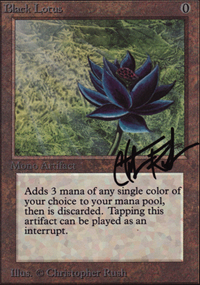Black Lotus (Magic: The Gathering card)

Black Lotus is a card in the collectible card game Magic: The Gathering that was published by Wizards of the Coast in the earliest editions of the game. A player may sacrifice the card when it is in play to generate three mana, the game's resources, that provide a means for the player to cast spells (play cards from the hand). Because it provides mana so quickly, it allows the player to cast spells earlier than their opponent, thus providing an advantage to the player. For this reason, it is one of the Power Nine, which are considered the most powerful cards in the game's history.
The card is banned in most competitive formats. Its power, limited print and distribution has made it one of the most valuable Magic cards. In the early 2020s, two copies of the card were sold for approximately $500,000 each.
History and design[edit]
Christopher Rush illustrated the card's art.[1] Black Lotus was printed for the earliest core sets of Magic: The Gathering, the Limited Edition Alpha and Beta sets, and the Unlimited set, which were all released in 1993.[2][3] The Alpha and Beta editions had black borders, and the Unlimited edition had white borders.[4]: 52 The Black Lotus is an artifact card that players can put into play for free, since it requires zero mana to cast. Players can sacrifice (discard it from play) to add three mana of one color to their mana pool.[4]: 52 Since a deck may contain four copies of any non-land card, a player could have four Black Lotus cards in their deck, providing a significant advantage in the early stages of the game.[2]
Individual cards are often referred to by the print release, such as Alpha Black Lotus. Approximately 1,100 Black Lotus cards were printed for Alpha,[1] 3,300 for Beta,[5] and over 18,000 for Unlimited.[3] In addition to the original, tournament-playable printings of Black Lotus, there are a few other promotional versions produced by Wizards of the Coast, that are not permitted in tournament play. These include artist proofs, Collectors' Edition cards, and oversized versions.
The card is banned from most competitive Magic formats owing to its power and relative scarcity. The only competitive setting in which it is not banned is the "Vintage" format, where only one copy of the card is allowed instead of the usual four.[5] The card was omitted from Revised Edition, the core set that followed Unlimited, as were all other Power Nine cards, and none have been published in any subsequent set.
Sales and legacy[edit]
The card's power and limited print has made it the most expensive Magic card, with mint condition Alpha cards being among the most valued.[2] Considering this, publisher Wizards of the Coast stated that the card would not be reprinted, which would hurt its value among collectors. It was included, along with the other Power Nine cards and numerous other cards from the early sets of Magic: the Gathering, to the Reserve List, a list of cards that Wizards of the Coast stated would never be reprinted.[6]: 202
The 30th Anniversary set published by Wizards of the Coast in 2023 reprinted 15 cards from the original set, including Black Lotus.[7] These are proxy cards[8] with unique backs, making them ineligible for tournament play, and use a modern card frame instead of the classic frame from the original version.[9]
In 2013, a high quality copy of the card was sold on eBay for $27,302.[5] In 2021, a copy of the card signed by Rush sold for $511,100.[10] In 2022, Post Malone, a fan of Magic, bought a signed artist's proof of the card for $800,000.[11] In 2023, a copy of the card sold for $540,000.[1] In both instances, the cards had a perfect grading score.
Since the card's initial release, future "lotus" cards have been made.[12] A parody of the card, called "Blacker Lotus", was made, and it required the player to tear it into pieces.[3]
References[edit]
- ^ a b c Welsh, Oli (2023-03-17). "Magic: The Gathering Black Lotus card sells for a record $540,000". Polygon. Archived from the original on 2023-03-17. Retrieved 2023-11-17.
- ^ a b c Jones, Tegan (2021-02-09). "A Short History Of Black Lotus, MTG's Rarest Card". Gizmodo Australia. Archived from the original on 2021-02-09. Retrieved 2023-11-17.
- ^ a b c Creswell, Jacob (2021-02-08). "Magic: The Gathering - Here's How Many Black Lotuses Are Left". CBR. Archived from the original on 2021-02-08. Retrieved 2023-11-17.
- ^ a b Kaufeld, John; Smith, Jeremy (2006). Trading card games for dummies. Wiley Publishing. ISBN 978-0-471-75416-9.
- ^ a b c Gerardi, Matt (2013-11-21). "Rare Magic: The Gathering card sells for more than $27,000". The A.V. Club. Archived from the original on 2019-03-22. Retrieved 2023-11-17.
- ^ Chalk, Titus (2017). Generation Decks: the unofficial history of gaming phenomenon Magic: The Gathering. Solaris Books. ISBN 978-1-78618-067-4.
- ^ Adler, Matthew (2023-03-18). "Magic: The Gathering's Most Sought After Card Sells For Record $540,000". IGN. Archived from the original on 2023-03-18. Retrieved 2023-11-17.
- ^ Dinsdale, Ryan (28 November 2022). "The rarest card in Magic: The Gathering's Anniversary Set is one in $100,000 worth of packs". IGN. Retrieved 23 November 2023.
- ^ Russell, Mollie (27 October 2023). "Proxy MTG Black Lotus sells for $5,000 at auction". Wargamer. Retrieved 23 November 2023.
- ^ Hall, Charlie (2021-01-27). "Magic: The Gathering Black Lotus card sells for $511,100 at auction". Polygon. Archived from the original on 2021-01-28. Retrieved 2023-11-17.
- ^ Jones, Dustin (2023-08-03). "Post Malone bought Magic: The Gathering's 'One Ring' card valued as high as $2 million". National Public Radio. Archived from the original on 2023-08-03.
- ^ "What is Black Lotus? MTG's most valuable card". Dexerto. 2023-08-16. Archived from the original on 2023-08-07. Retrieved 2023-11-17.
External links[edit]
- Black Lotus at Wizards of the Coast Gatherer
- Dariani, Omeed (27 May 2003). "All-time MVPs: Black Lotus". Archived from the original on 11 September 2019.
